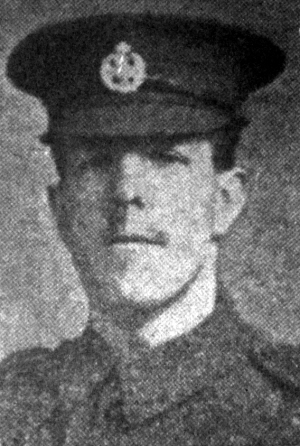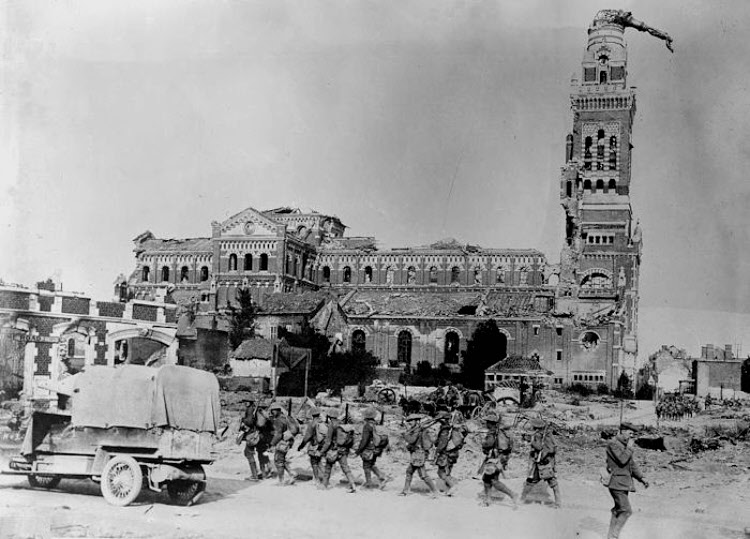
608690, London Regiment (London Irish Rifles), 1st/18th Battalion
Herbert Boocock was born in 1884, the first of the ten children born to William Henry Boocock and his wife Lydia (nee Smith) who married at Ossett Holy Trinity Church on the 26th December 1881. In 1891 and also in 1901, William Henry Boocock, wife Lydia and their children, were living on Prospect Road, Ossett. Both parents and their seven surviving children were all born in Ossett. In 1901, Herbert, now aged 17 years, was working as an assistant postman. By 1911 William Henry Boocock, Lydia and five of their children are still living at Prospect Road, Ossett. William Henry Boocock died aged 63 years in 1922 and his wife Lydia died in 1923, aged 62 years.
On the 14th March 1903, at Chapelthorpe St James’ Church, Herbert, a postman, married Rose Maude Linnington of Calder Grove, Wakefield. In their eight year marriage, Rose Boocock had borne four children, but sadly only two of them had survived. Only one of these surviving children, Herbert (born 1904), was living with his parents in 1911. The recently widowed Rose Maud Boocock died in 1919 in the Bradford area aged 34 years.
The London Regiment was unusual. Not only were all of its battalions of the Territorial Force (although the first four were affiliated to the other City of London regiment, the all-regular Royal Fusiliers) but each battalion was regarded as a Corps in its own right.
1/18th (County of London) Battalion (London Irish Rifles) was formed in August 1914 at the Duke of York’s Headquarters, Chelsea as part of 5th London Brigade, 2nd London Division. They moved on mobilisation to the St. Albans area. On the 10 March 1915 they landed at Le Havre and on the 11th May 1915, the formation became 141st Brigade in 47th (2nd London) Division.
Rifleman Herbert Boocock was killed in action during the 2nd Battle of Bapaume, which took place between th4e 21st August and the 3rd September 1918. The British and Commonwealth attack is often taken to be the turning point of the First World War on the Western Front and the beginning of what was later known as the Allies’ Hundred Days Offensive.
The 1/18th Battalion of the London Irish Rifles as part of 47 (2nd London) Division were tasked with taking Bouchavesnes and Rancourt on the 1st September 1918. Advancing to the west of St Pierre Vaast wood, Bouchavesnes, near Rancourt, they succeeded in their objective, but took several casualties.
“On August 31st the 47th Division had merely to swing forward on the right flank to conform with an advance of the 58th Division and Australian Corps. The 142nd Brigade closed in to the left, and the 141st Brigade on the right formed the lower end of the pendulum. The former gained most of their objective during the night by peaceful penetration, and the 141st Brigade moved forward successfully at 5.30 a.m. under a creeping barrage, and gained all the ground required, together with 184 prisoners. The morning was diversified by a determined counter-attack made by a battalion of the German 13th Reserve Division from Rancourt towards Le Foret and Priez Farm. A part of this attack reached our 18th Battalion and a company of the 19th which had been hastily moved up, and it was completely repulsed after brisk hand to hand fighting; the rest was caught by artillery barrage and direct machine-gun fire and did not reach our line.
The advance went ahead next day, turned slightly north-east to prepare for a wide encircling movement from the south intended by the IIIrd Corps. The objective was the west edge of St. Pierre Vaast Wood. The 141st Brigade on the right, and the 140th on the left, successfully took this line with many prisoners, and a motor ambulance complete with driver and two doctors, which fell into the hands of the 140th Brigade at Rancourt.
During the morning it was found that the enemy still held Priez Farm, which was on the left of our line, at its junction with that of the 18th Division. The 142nd Trench-mortar Battery and two platoons of the 23rd Battalion were ordered to deal with them. A hurricane bombardment by Stokes mortars was directed on the point, after which the garrison was captured. Eighty of them were taken by Captain Blofeld and one man of his battery.” 1
The “Ossett Observer” 2 had this obituary for Rifleman Herbert Boocock:
“Former Ossett Postman Killed – Among the local men who have lost their lives in recent fighting is Rifleman Herbert Boocock (34), London Irish Rifles, a postman by vocation and a son of Mr. William Henry Boocock, of Prospect-road, Ossett. Deceased leaves a widow and two children, the latter aged 14 and 9 years respectively, and his wife, whose maiden name was Rose Maud Linnington, hailed from Calder Grove. On leaving school deceased first became a telegraph messenger and afterwards a postman in the borough, being in the employ of the local post office for over thirteen years, and then he was transferred to Nottingham, and afterwards to Shipley, at which latter place he was stationed at the time he joined the army. This was in June, 1915, and he was first attached to the Post Office Rifles. He went to France at Easter last. On Sunday intimation was received from the War Office that Rifleman Boocock was killed in action on the battlefield on September 1st. Two of his brothers are in the army, Allan (22), being at present in hospital at Manchester, suffering from severe wounds in the right arm and legs, and Thomas (19), who is serving with a labour battalion in France.”
Herbert’s army service record has not survived, but he was awarded the British and Victory medals, but not the 1914-15 Star, indicating that he did not serve overseas before 31 December 1915. At Wakefield, on the 19th December 1925, administration of the estate of Herbert Boocock, whose death was recorded as the 1st September 1918, was granted to his son, Herbert Boocock, miner. Effects £269 1s 8d. Herbert Boocock junior, born in late 1904, died at Dewsbury General Infirmary, aged 34, in February 1939 and was buried at Ossett Holy Trinity Church on the 21st February 1939.

Above: British troops en route for Bapaume pass through Albert with its shell-damaged cathedral in August 1918.
Rifleman Herbert Boocock was killed in action on the 1st September 1916, aged 34 years, the son of the late William and Lydia Boocock and husband of the late Rose Maud Boocock (nee Linnington). His body was never recovered and he is remembered on Panel 10 at the Vis-En-Artois Memorial, 3 Pas de Calais, France. Vis-en-Artois and Haucourt are villages on the straight main road from Arras to Cambrai about 10 kilometres south-east of Arras. The Memorial is the back drop to the Vis-en-Artois British Cemetery, which is west of Haucourt on the north side of the main road.
This Memorial bears the names of over 9,000 men who fell in the period from 8 August 1918 to the date of the Armistice in the Advance to Victory in Picardy and Artois, between the Somme and Loos, and who have no known grave. They belonged to the forces of Great Britain and Ireland and South Africa; the Canadian, Australian and New Zealand forces being commemorated on other memorials to the missing.
The Memorial consists of a screen wall in three parts. The middle part of the screen wall is concave and carries stone panels on which names are carved. It is 26 feet high flanked by pylons 70 feet high. The Stone of Remembrance stands exactly between the pylons and behind it, in the middle of the screen, is a group in relief representing St George and the Dragon. The flanking parts of the screen wall are also curved and carry stone panels carved with names. Each of them forms the back of a roofed colonnade; and at the far end of each is a small building.
References:
1. The History of the 47th (London) Division: 1914- 1919
2. “Ossett Observer”, 28th September 1918